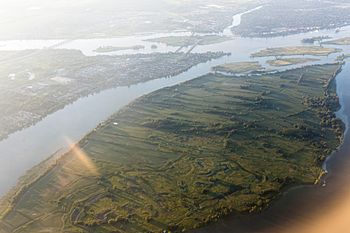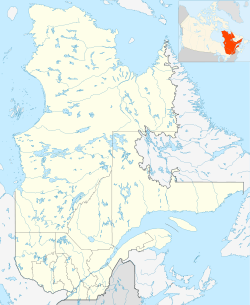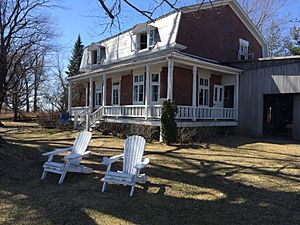Sainte-Thérèse Island (Saint Lawrence River) facts for kids
|
Native name:
Île Sainte-Thérèse
|
|
|---|---|

Aerial view of Île Sainte-Thérèse and part of the Hochelaga archipelago
|
|
| Geography | |
| Location | Saint Lawrence River, in Varennes, Marguerite-D'Youville Regional County Municipality, Montérégie, Québec, Canada |
| Coordinates | 45°40′54″N 73°28′13″W / 45.6817°N 73.4703°W |
| Archipelago | Hochelaga Archipelago |
| Length | 4.8 km (2.98 mi) |
| Width | 1.6 km (0.99 mi) |
| Administration | |
Île Sainte-Thérèse (which means Sainte-Thérèse Island in English) is an island found in the Saint Lawrence River. It is located northeast of the Island of Montreal. This island is part of the town of Varennes in Quebec, Canada.
The island covers about 5.4 square kilometers (2.1 square miles). This makes it the fifth largest island in the Hochelaga Archipelago.
Contents
Exploring the Geography of Sainte-Thérèse Island
Île Sainte-Thérèse is about 4.8 kilometers (3 miles) long and 1.6 kilometers (1 mile) wide. The ground beneath the island is made of different types of rock. The western part has limestone, and the eastern part has clay shale. On top of this is a layer of clay and sand, which is good for farming.
The edges of the island are made of clay and sand. These parts can easily wear away due to water and waves. The island's edge is about 11 kilometers (6.8 miles) long. Most of the island has no people living there and you can only reach it by boat.
The island has farms, wet areas called marshes, and forests. One farmer grows soybeans there. Many small cabins, called chalets, are around the island. Most of these are on land owned by the Government of Quebec. Some private homes still exist, like the Durocher house. This house shows what the island was like when it was mostly farmland.
A Journey Through the History of Sainte-Thérèse Island
The first people to live on Sainte-Thérèse Island were the Indigenous people of the Saint Lawrence valley. The oldest items found on the island are about 2,500 years old. Digs in the 1980s showed that Indigenous people often visited the island. They likely stayed for short times, as there is no sign of long-term settlements. Early French writings say the Iroquois used the site. In 1665, Charles Le Moyne d'Iberville was captured there while hunting.
French Rule: Early Days of the Island
In 1662, Ignace Boucher was given the island as a noble fief (a type of land grant). The name Sainte-Thérèse was first used around this time. It likely refers to the new queen, Marie-Thérèse. Pierre Boucher wrote about the island in 1664. French settlers probably did not live on the island until 1667.
Michel-Sidrac Du Gué de Boisbriand got permission to settle on the island in 1667. He became the first known European resident. Du Gué de Boisbriand was a captain in the Carignan Regiment. He came to America with the Carignan-Sallière expedition. In 1667, he and Jean Hayet dit Malo cleared the island. They sent many oak logs to the Quebec shipyard. One ship built with wood from the island was named the Griffon.
In 1672, Du Gué de Boisbriand was given the Seigneury of Île Sainte-Thérèse. This included Sainte-Thérèse Island and nearby islands. He also had land on the western tip of the Island of Montreal, called Boisbriand. Du Gué de Boisbriand was busy with his military career and trading. He lived sometimes in Boisbriand and sometimes on Sainte-Thérèse Island.
In 1674, he gave two plots of land on the west side of the island to Mathurin Gauthier dit Landeville and Antoine Hoquet dit le Picard. In 1675, he rented his farm on the island to Nicolas Ragueneau and Louis Truchon dit Léveillé for five years.
Around 1679, Du Gué de Boisbriand moved to Sainte-Thérèse Island with his wife, Marie Moyen. He seemed to like the island and its views. He even named his first daughter Marie-Thérèse. A count of the population in 1681 showed that seven children, two male servants, and one female servant lived in the lord's manor. He had 40 arpents (about 34 acres) of land, 16 cattle, and a flour mill. The 1681 count listed 53 people living on the island in 14 homes. These homes were around the island, close to the shore.
Among these islanders was Louis Brien dit Desrochers. He is the ancestor of the Brien, Desrochers, and Durocher families in America. Louis came from Brittany, France. He was a tailor in Trois-Rivières and then Montreal. He married Suzanne Bouvier in 1681. That same year, he settled on Sainte-Thérèse Island. Many of his family members lived on the island until 1952.
Another islander was Jean Bousquet, a master gunsmith. He moved to the island in 1680 with his wife, Catherine Fourrier. Jean Voyne (Venne) also came to the island in 1675. He married Catherine Bousquet, Jean Bousquet's daughter. They had many children who carried the Venne name. Many of them settled in Pointe-aux-Trembles.
Nicholas Choquet, a soldier, was also among the first islanders. He farmed on the island in 1667. In 1681, he owned land in Varennes and settled there. He had many descendants named Choquet or Choquette.
Charles Desmares, a shoemaker, owned a farm on the island in 1681. Through his son Basil, he is the ancestor of the Desmarrais families in Varennes and Boucherville.
Du Gué de Boisbriand passed away in 1689. It seems he had money problems, as his property on Sainte-Thérèse Island was not well kept. He left his family and his land to his friend Charles-Gaspard Piot de Langloiserie. This French gentleman arrived in New France in 1691. That same year, he married Du Gué's oldest daughter, Marie-Thérèse.
By 1695, the island's population had grown by 60% since 1681. This showed how rich the land was. Gideon de Gascogne visited in the early 1700s. He said the land was good for growing all kinds of grains and vegetables. He noted that "all the inhabitants are very comfortable there."
Jean-Sidrac Du Gué de Boisbriand, the first lord's oldest son, sold his title to his brother-in-law, Piot de Langloiserie, in 1706. Piot de Langloiserie died in 1715. His wife, Marie-Thérèse Piot (née Du Gué), managed the land for about 25 years. In 1740, she got an order to stop animals from freely grazing on islands near Sainte-Thérèse Island. This was a common practice at the time.
A record of the island's land in 1723 showed 23 plots with 19 houses.
In 1742, Louis-Hector Piot de Langloiserie became the new lord. He was the oldest son of Hector and Marie-Thérèse. There were talks of him marrying Marguerite Du Frost de la Jammerai, who later became Mère d'Youville. But he later married Esther Bridge and lived for a time in the English colonies. In 1726, he got permission to fish for porpoises in New York. He lived there for several years before returning to Quebec. When he became lord in 1742, he worked as an interpreter for the governor in Quebec.
During the English conquest, General Murray used Île Sainte-Thérèse in 1760. He camped his troops there before taking Montreal. Murray drew a detailed map of the island and its surroundings.
British Rule: Changes and Challenges
After the English conquest, Louis-Hector Piot de Langloiserie lost his land. His property was taken in 1778. It was given to John Maxwell, an English businessman. Maxwell sold it the next year to Louis-Joseph Ainsse (or Hainse), who lived in Varennes.
Louis-Joseph Ainse was a successful trader. He became the official lord of Île Sainte-Thérèse in 1781. That same year, he hired someone to build the island's first windmill. He died in 1802. His son, Joseph Ainse, became the next lord. Joseph married Charlotte Vigneau in 1817. It is not clear if the two Ainse lords lived on the island full-time. Their homes were known to be in Varennes. Local stories say a large manor house was on the southwestern tip of the island.
Two of Joseph Ainse and Charlotte Vigneau's daughters played a role in the Patriots' uprising of 1837-38. Françoise Ainse was the wife of Doctor Eugène-Napoléon Duchesnois. Zoé Ainse was the wife of Amury Girod. Girod was a Swiss farmer who wrote several articles and books. These included "Conversations on agriculture, by an inhabitant of Varennes" (1834) and "Notes divers sur le Canada" (1835). We know that he and his wife lived on the island. Local history says the Ainse manor house on Sainte-Thérèse Island had a printing press. This press was used to print "La Minerve," the Patriots' newspaper.
Girod and his brother-in-law, Doctor Duchesnois, joined the Sons of Liberty. Girod kept a diary in German and Italian. It described the events of 1837 in detail. In November 1837, Papineau and Edmund Bailey O'Callaghan canoed from Pointe-Aux-Trembles to Île Sainte-Thérèse to find Girod. They found him in Varennes the next day. There, they had an important meeting that led to the armed uprising. Girod wrote in his diary about the decision to call a meeting and form a temporary government. They also decided to organize people and get weapons. Papineau and others went to fight at Saint-Charles, and Girod went to Saint-Eustache.
During the first half of the 1800s, there is not much information about the island's residents. However, the population stayed steady. Between 1723 and 1859, the number of plots and houses remained similar, around 19. In 1841, the island had its first school teacher. Even though the island was good for farming, it had no village or church. So, residents relied on Varennes and Pointe-Aux-Trembles for shopping, religious matters, and official business. The island's population started to shrink in the second half of the 1800s. By 1897, only 12 plots were left. In 1942, there were 7, and in 1944, only 5. In the early 1950s, the Saint Lawrence Seaway opened. Icebreakers began to pass, which cut off the island from the south shore in winter. Because of this, the last residents left. Among them were Raoul Durocher, a descendant of Louis Brien dit Desrochers, and his wife Marie-Anna Provost.
In the 1950s, the island was known for its beaches on its southeast side. These included Choquette and Bissonnette beaches. A ferry service brought visitors from Varennes and Montreal. The Beaudoin family from Pointe-Aux-Trembles ran some of these ferries.
In the early 1980s, a park was created on Île Sainte-Thérèse. A ferry brought visitors from Varennes and Pointe-Aux-Trembles. The park had a bike path, rest areas, and picnic spots. This park closed in the late 1980s.
In the 2010s, the mayors of Varennes and Pointe-aux-Trembles planned a new park project. In 2015-2016, the Quebec Ministry of Natural Resources removed several vacationers who were staying on the island without permission.
Understanding the Ecology of Sainte-Thérèse Island
Île Sainte-Thérèse has many different natural areas. These include woodlands around its edges, central meadows, and swamps. It is seen as an important place for wildlife. You can find fish like muskellunge here. Birds like herons, bitterns, terns, and gulls also live on the island. Mammals such as field voles, raccoons, red foxes, long-tailed weasels, and muskrats are present too. The swallow of shore (or sand swallow) is very common on the island's banks.
Waterfowl (birds that live near water) are also plentiful. Duck Unlimited built a marsh there in the 1980s to help these birds.
Île Sainte-Thérèse has been part of several park plans since the 1970s. However, it faces many environmental problems. Since the Saint Lawrence Seaway opened in the 1950s, the southeastern shores of the island have been affected by erosion. This erosion is caused by the waves from boats. In some areas close to the seaway, the shores wear away by 1 to 2 meters (3 to 6 feet) each year.
In the 1980s, a sewage treatment plant was built. Its outflow pipe, from Île aux Vaches, released Montreal's wastewater near the island's southeast side. This made the water quality worse. Swimming, which was once popular on the island, is now not possible.
Preserving the Heritage of Sainte-Thérèse Island
The island holds important archaeological sites. These include places where Indigenous people lived and sites from the early days of European settlement.
Many of the old houses and buildings on the island are now in ruins. One house, built around 1913 by Noël Alias Durocher, is still standing. Members of the Durocher family continue to take care of it.
Several lighthouses of different sizes are located around the island.
Images for kids





